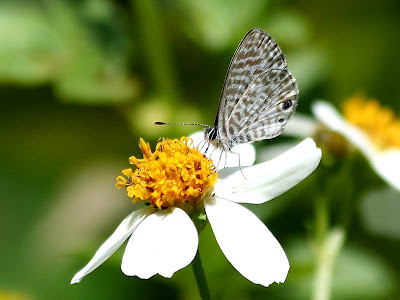The Celebration of Learning started four years ago, the brain child of our newest president. I went to the first one with an open mind. After sitting through a mind-numbing speech stating the obvious—students come to college to learn—and two excruciatingly boring break-out sessions, I went to the buffet lunch to find that the caterers hadn't cooked enough food. Like my experience with the McGriddle at McDonald's, I was foolish enough to try the Celebration of Learning only that one time.
So Elizabeth, who played hooky with me, and I decided to visit some places in the city that everyone knows about but which we had never seen. We started at the Audubon Center for Birds of Prey. The center is clean, spacious, and well-staffed; the birds are magnificent. I took a number of pictures that I wouldn't be able to get unless the raptors were tethered to a perch:


And since the center had a small butterfly garden, I was shooting the bugs as well, like this tiny cassius blue:

The center is on a lake, where an immature, very tame white ibis posed:

I enjoyed the photo ops but not the idea of the center. One of the volunteers explained that in the wild, most raptors die in their first year, but in captivity, they live considerably longer. The smaller birds in the aviaries didn't seem to have a bad life. But I felt awful about the bald eagles and large owls roped to posts with six-foot tethers. Trees shaded their area, but if a beam of sunlight found a large enough hole in the canopy, there was no where to escape. They reminded me of old folks in nursing homes. Were they content just to be alive, enjoying the taste of raw meat for scheduled dinners and the travels of the sun across the sky? Or would they have preferred death to this confinement? Their stoic, noble faces didn't reveal the answers.
The goal is to release as many of the birds back into the wild as possible. Those with severe injuries—amputated wings after collisions with power lines, for example—help educate the visitors. But the birds' existence at the center is such a reduction from their lives in the wild. I can't imagine losing a range measured in miles for one where a six-foot tether determines the farthest one can travel.
On the way home, we stopped at the Orlando Science Center because billboards in the city indicated that the Our Body: The Universe Within exhibit had begun. We should have confirmed that before paying the $15 admission. The staff was still arranging the dead bodies, so we were left touring exhibits appropriate to 10-year-olds. All of the dinosaur bones were fakes; all of the hands-on learning opportunities were stretched, chipped, and inaccurate from too much use. I did get one cool picture, though, shooting from the dinosaur room into kiddie science area:

All in all, Elizabeth and I celebrated learning in a much more meaningful way than did our colleagues stuck on campus.


